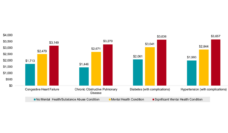A growing body of research has shown that interventions aimed at the social determinants of health, such as housing, education, food access, and social support networks, can improve health outcomes. These health improvements are important and welcome in our pursuit of population health. Yet it is important to distinguish interventions that improve health at some additional cost from interventions that improve health and save money.
To date, little is known about the role that investments in the social determinants of health play in reducing health care spending. Prior work examining the health care costs of Medicare beneficiaries has shown that spending is lower in communities with greater investment in these non-medical factors that influence health outcomes. Such investments have the potential to help bend the health care cost curve, at least for some populations. Health care spending for non-elderly Americans, however, often follows different patterns than Medicare spending. Findings for Medicare beneficiaries may not translate to the millions of non-elderly adults with employer-sponsored health insurance.
My colleague, Mac McCullough, and I analyzed data from two distinct data sources – the Census of Governments and the Health Care Cost Institute. The Census of Governments provided us with estimates of how much local governments spend annually on a comprehensive set of public health and social services. Combining these data with data from the Health Care Cost Institute allowed us to determine the per capita health care costs of non-elderly adults with employer-sponsored health insurance.
Our analysis showed that, in communities with the lowest levels of government spending on public health and social services, health care spending for near-elderly adults ages 55–64 was about 20% higher than in all other communities. For adults ages 18-54, on the other hand, we found no relationship between health care costs and governmental spending on public health and social services. In other words, communities that spent the least on public health and social services also spent more on private health care for some working-age adults. But that relationship did not persist across all ages of adults and did not appear to be linear or present in all communities.
Our findings did not come from a randomized study and it is important to keep in mind that correlation (what we found here, or, more accurately didn’t find here) is not causation. Investing in the social determinants of health can make a difference in the health of a community. In some contexts, such investments may result in decreased health care spending. Our analysis suggests that those health gains do not automatically translate into meaningful health care cost savings for the privately insured. Local government investments in public health and social services, while important for the community, may not solve every problem for everyone.
An important implication of our findings is that we might need to temper our expectations for engaging employers and private health insurers in investing in the social determinants of health. Broad spending on the social determinants may not always be associated with meaningful reductions in employer-sponsored healthcare spending. This may be especially instructive if private employers seek to engage with the social determinants of health for cost-saving reasons. If healthcare cost offsets are a goal, it may be important to focus employer investments on specific social needs of subsets of their populations. However, there are a host of other reasons why private employers may engage with social-determinants-related work. For example, promoting overall community health might help employers recruit and retain a skilled workforce or further their corporate social responsibility goals.
More generally, our findings provide a call to action to policymakers, researchers, and health system stakeholders. We need to examine carefully the specific settings or populations for which targeted investments in the social determinants of health may help to bend the healthcare costs curve. Our work found that such investments show only a weak relationship with health care costs for the privately insured. Investing in the social determinants of health might be able to make a larger difference in the costs of care provided to patients covered by Medicaid and similar means-tested programs. Earlier work for Medicare beneficiaries showed that the savings potential is greatest among lower-income communities. Targeting investments at communities with high proportions of Medicaid beneficiaries might have more favorable returns.














